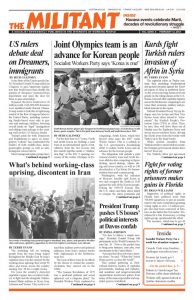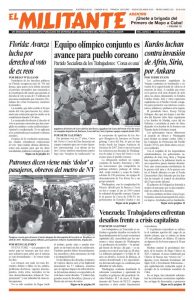HAVANA — Carrying what looked like a river of torches, thousands of youth, overwhelmingly college and high school students, marched from the steps of the University of Havana through the city’s streets on the night of Jan. 27. The annual celebration of the anniversary of the birth of Cuban national hero José Martí is an expression of pride in the history of revolutionary struggle in Cuba against colonial and imperialist domination. Similar actions took place across the island.
Cheers greeted the arrival of President Raúl Castro and other Cuban leaders who joined the front line of the March of the Torches here. In a festive atmosphere, youth came in contingents from schools across Havana. The action was sponsored by the Federation of University Students (FEU) and Federation of High School Students. Also participating were young workers and military cadets, many of them members of the Union of Young Communists, as well as working people of all ages.
FEU national President Raúl Alejandro Palmero told the assembled youth that the first March of the Torches, called by the student federation, was held Jan. 27, 1953. It was the first large street action opposing the U.S.-backed Batista dictatorship, which had taken power in a military coup the previous year.
With that 1953 mobilization, wrote Armando Hart in his firsthand account Aldabonazo: Inside the Cuban Revolutionary Underground, 1952-58, “the university-based movement of civil and political protest took on a new character.” … The nearly 5,000 students and workers “came equipped with the means to defend themselves and strike back” if attacked by Batista’s cops or military. “San Lázaro Street was lit up by their burning torches, symbol of the liberty that was theirs to conquer.”
The contingent of 500 young Cubans led by Fidel Castro in the 1953 March of the Torches, wrote Hart — a founding leader of Cuba’s revolutionary movement — “demonstrated a level of organization and a capacity for action that distinguished it among the student and popular masses.”
Six months later, on July 26, 1953, many of these same militants joined Castro in an armed assault on army barracks in the eastern cities of Santiago de Cuba and Bayamo. The attack opened an insurrectionary struggle that, under the leadership of the July 26 Movement and Rebel Army, overthrew the Batista dictatorship on Jan. 1, 1959, and brought a workers and farmers government to power. The victory established the first free territory of the Americas. This year’s march paid special tribute to Fidel Castro’s revolutionary leadership over decades until his death in 2016.
Martí statue inaugurated
On the morning after the student march, a ceremony was held at daybreak in a park in Old Havana to inaugurate a striking equestrian statue of José Martí, central leader of Cuba’s 19th century independence struggle against Spain. It’s a bronze replica of a statue created by American artist Anna Hyatt Huntington that has stood in New York’s Central Park since 1965. It dramatically depicts the independence fighter on horseback at the moment he was killed in battle in Dos Ríos, Cuba, in 1895.
The event was attended by President Raúl Castro, other Cuban leaders from all sectors of society, and some 300 guests from the United States, including more than 100 Cuban-Americans. Among the visitors were not only supporters of the Cuban Revolution but numerous figures from the art world who had worked to bring the project to completion, Democratic and Republican political figures, and some of those who made significant donations to the $2.5 million fund raised to reproduce the statue and ship it from the United States.
The keynote speaker was Eusebio Leal, historian of the City of Havana, for whom the installation of the statue was the culmination of two decades of effort. Also speaking was Joseph Mizzi, chair of the board of trustees of the Bronx Museum of the Arts, which led the fundraising effort. A message from New York Mayor Bill de Blasio was read by José Velázquez from the mayor’s office. Later that day a concert in Old Havana paid tribute to Holly Block, former executive director of the Bronx Museum, who was centrally involved in the project until her death last year.
A Jan. 28 Reuters article, headlined “Trump Casts Pall on Inauguration of U.S. Statue of Martí in Cuba,” labeled the ceremony a “sober affair.” While some guests from the U.S. did see it as another “anti-Trump” event, for Cubans across the island the weekend actions were a reaffirmation of their 150-year history of revolutionary struggle.

